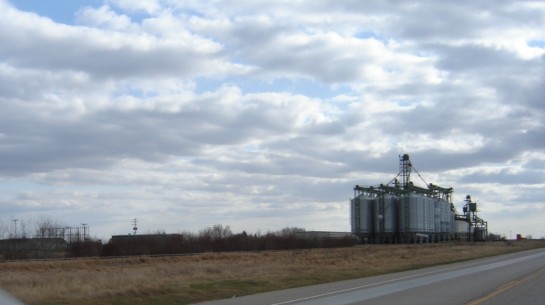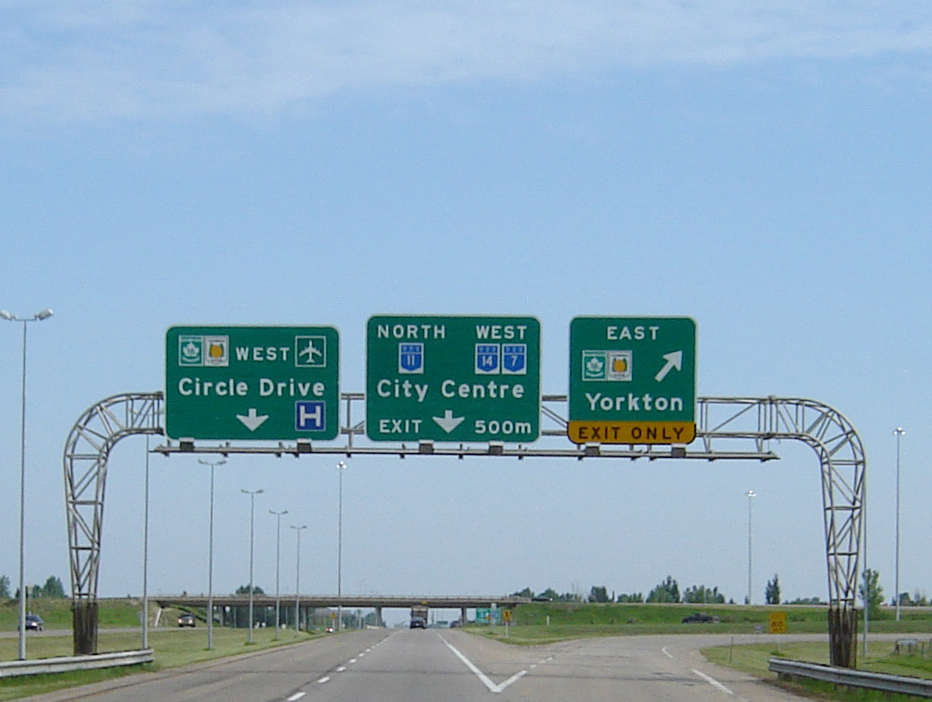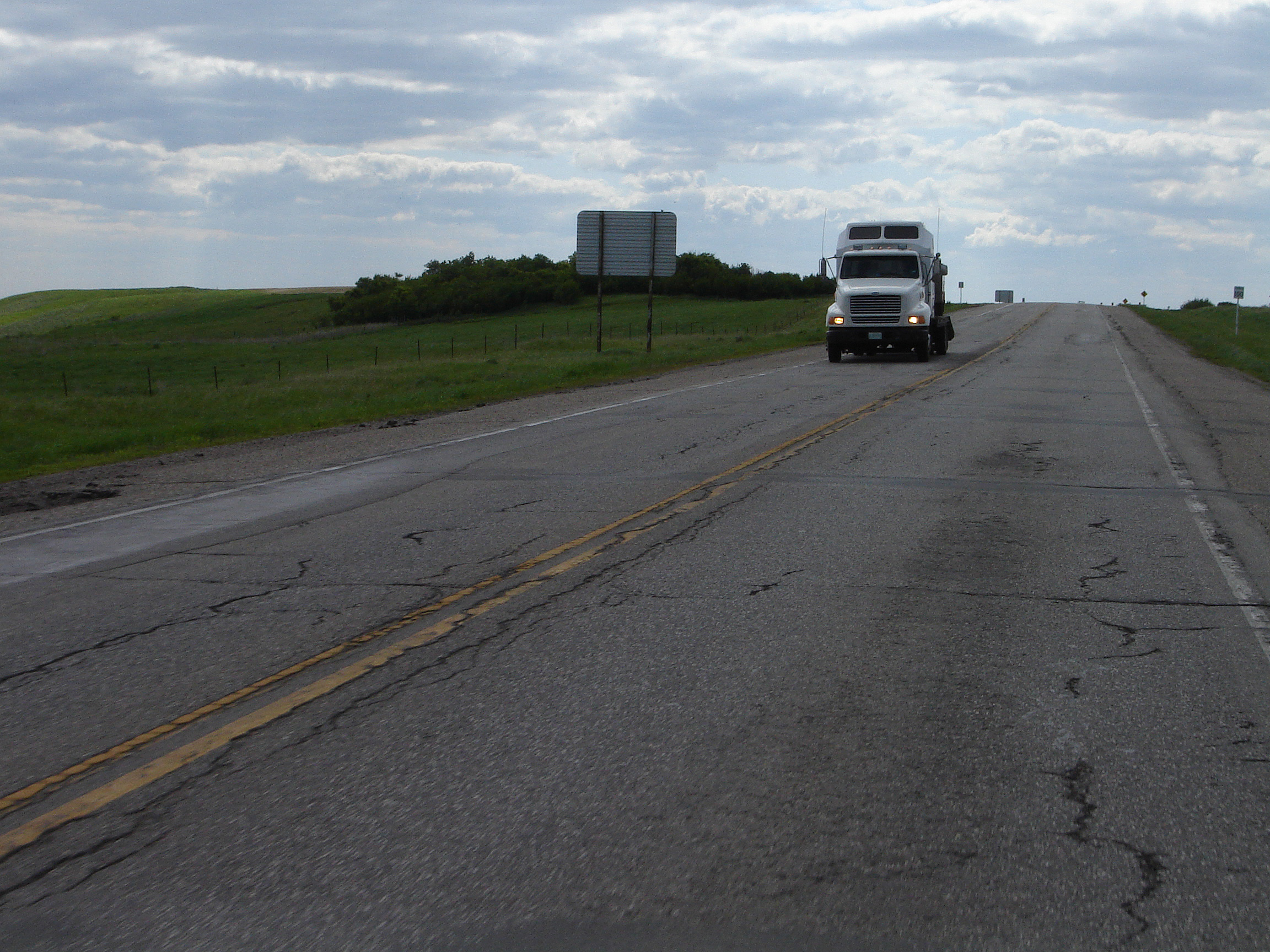|
Saskatchewan Highway 7
Saskatchewan Highway 7 is a major paved undivided provincial highway in the Canadian province of Saskatchewan, running from the Alberta border to Saskatoon. Highway 7 continues west into Alberta where it becomes Alberta Highway 9. Highway 7 is an important trade and travel route linking Saskatoon with several of its bedroom communities such as Delisle and Vanscoy, as well as larger centres farther afield such as Rosetown and Kindersley. Its primary use, however, is by travelers heading for Calgary, Alberta and the Canadian west coast. Despite being one of the most heavily used roads in the province, as of 2020, there is only approximately 36.5 km of the route that is divided highway; 34.5 km from Saskatoon to Delisle, including a recently completed bypass of Vanscoy, and 2 km just east of Rosetown at the Rosetown Airport and Cargill inland terminal. In 2020, the provincial government announced funding to install eight passing lanes east of Kindersley, as well a ... [...More Info...] [...Related Items...] OR: [Wikipedia] [Google] [Baidu] |
Ministry Of Highways And Infrastructure (Saskatchewan)
The Ministry of Highways is divided into the Operations, Policy and Programs, and Corporate Services Divisions and the Communications Branch. The ministry is the employer of over 1,476 employees diversified amongst 105 communities in Saskatchewan. The current Minister of Highways and Infrastructure is Fred Bradshaw. Operations Division The Operation Division has the responsibility of maintaining of asphalt concrete pavements, of granular pavements, of thin membrane surface (TMS) highways, of gravel highways, of ice roads, bridges, large culverts, 12 ferries, one barge and 17 northern airports. Operational maintenance includes surface repair activities like crack filling, sealing, and patching; snow and ice control; pavement marking; signing; and ferry operations. Along with engineering, construction and design of the provincial road network, the operations division provides regulations, inspections and advice to the rural municipalities (R.M.) for the municipal r ... [...More Info...] [...Related Items...] OR: [Wikipedia] [Google] [Baidu] |
Saskatchewan
Saskatchewan ( ; ) is a Provinces and territories of Canada, province in Western Canada, western Canada, bordered on the west by Alberta, on the north by the Northwest Territories, on the east by Manitoba, to the northeast by Nunavut, and on the south by the United States, U.S. states of Montana and North Dakota. Saskatchewan and Alberta are the only landlocked provinces of Canada. In 2022, Saskatchewan's population was estimated at 1,205,119. Nearly 10% of Saskatchewan’s total area of is fresh water, mostly rivers, reservoirs and List of lakes in Saskatchewan, lakes. Residents primarily live in the southern prairie half of the province, while the northern half is mostly forested and sparsely populated. Roughly half live in the province's largest city Saskatoon or the provincial capital Regina, Saskatchewan, Regina. Other notable cities include Prince Albert, Saskatchewan, Prince Albert, Moose Jaw, Yorkton, Swift Current, North Battleford, Melfort, Saskatchewan, Melfort, and ... [...More Info...] [...Related Items...] OR: [Wikipedia] [Google] [Baidu] |
Asphalt Concrete
Asphalt concrete (commonly called asphalt, blacktop, or pavement in North America, and tarmac, bitumen macadam, or rolled asphalt in the United Kingdom and the Republic of Ireland) is a composite material commonly used to surface roads, parking lots, airports, and the core of embankment dams. Asphalt mixtures have been used in pavement construction since the beginning of the twentieth century. It consists of mineral aggregate bound together with asphalt, laid in layers, and compacted. The process was refined and enhanced by Belgian-American inventor Edward De Smedt. The terms ''asphalt'' (or ''asphaltic'') ''concrete'', ''bituminous asphalt concrete'', and ''bituminous mixture'' are typically used only in engineering and construction documents, which define concrete as any composite material composed of mineral aggregate adhered with a binder. The abbreviation, ''AC'', is sometimes used for ''asphalt concrete'' but can also denote ''asphalt content'' or ''asphalt cement'', ... [...More Info...] [...Related Items...] OR: [Wikipedia] [Google] [Baidu] |
Tommy Douglas Collegiate
Tommy Douglas Collegiate Institute is a high school located in the Blairmore Suburban Centre district of western Saskatoon, Saskatchewan, serving students from grades 9 through 12. It is named for Tommy Douglas, the "Father of Canadian Medicare," leader of the Saskatchewan Co-operative Commonwealth Federation The Co-operative Commonwealth Federation (CCF; french: Fédération du Commonwealth Coopératif, FCC); from 1955 the Social Democratic Party of Canada (''french: Parti social démocratique du Canada''), was a federal democratic socialism, democra ... and premier of Saskatchewan from 1944 to 1961. The school is unique among Saskatoon public schools in that it is the first to be physically connected to both a regional recreation complex (Shaw Centre) and to a Catholic/separate school ( Bethlehem Catholic High School). Its feeder schools are Dundonald School, Ernest Lindner School, Fairhaven School, James L. Alexander School, Lester B. Pearson School, Montgomery School, ... [...More Info...] [...Related Items...] OR: [Wikipedia] [Google] [Baidu] |
Bethlehem High School (Saskatoon)
Bethlehem Catholic High School is a separate (Catholic) high school in Saskatoon, Saskatchewan, Canada, that opened in August 2007. It is located off 22nd Street West in the Blairmore Suburban Centre neighbourhood. Bethlehem serves students living on the west side of Circle Drive. This school integrates faith and learning in a facility featuring a chapel, two gymnasiums and a theatre. It is physically connected to the public high school Tommy Douglas Collegiate through the adjacent Shaw Centre recreation facility. Bethlehem was named after the birthplace of Jesus Christ, the foundation of the Christian religion. On June 7, 2009, a fire destroyed an addition containing portable classrooms still under construction. Damage was estimated at $750,000. The fire caused only minor damage to the existing building. The cause of the fire was determined to be arson Arson is the crime of willfully and deliberately setting fire to or charring property. Although the act of arson typi ... [...More Info...] [...Related Items...] OR: [Wikipedia] [Google] [Baidu] |
Blairmore SDA, Saskatoon
Blairmore Suburban Development Area (SDA) is an area in Saskatoon, Saskatchewan (Canada). It is a part of the west side community of Saskatoon. It lies (generally) north of the outskirts of the City and the Rural Municipality of Corman Park No. 344, west of downtown Saskatoon, and the Core Neighbourhoods SDA, south of the North West Industrial SDA, and west of the Confederation SDA. Most of the Blairmore SDA consists of undeveloped land annexed by the city in the mid-2000s. A total of nine neighbourhoods, primarily residential in nature, are ultimately planned for the SDA. As of late 2019, two are in the process of development: the commercial/residential Blairmore Suburban Centre and the residential community Kensington. A third residential area, Elk Point, is also in its early stages. Neighbourhoods * Blairmore Suburban Centre * Kensington, a residential community immediately north of the Suburban Centre, was approved in 2011, with construction beginning in 2013. ... [...More Info...] [...Related Items...] OR: [Wikipedia] [Google] [Baidu] |
Idylwyld Drive
Idylwyld Drive ( ) is an arterial road in Saskatoon, Saskatchewan. It is one of the main roads in and out of the downtown area of the city. On the south side of the Senator Sid Buckwold Bridge, it is a freeway and was initially designated as the Idylwyld Freeway (since 2013, the southern portion of the road has also been designated as Idylwyld Drive). It merges into Circle Drive at an interchange completed in 2013. At its north end the road divides into two highways, Highway 11 and Highway 12. The oldest section of Idylwyld Drive used to be known as Avenue A, the easternmost of the "lettered" north-south streets. In 1966, the Canadian National Railway tracks were relocated out of the downtown; the former railway bridge was demolished and replaced by a traffic bridge; and the former railroad right-of-way south of the river was made into the Idylwyld Freeway. The freeway crossed the river at the bridge and connected at 20th Street to Avenue A, renamed Idylwyld Drive. Two blocks ... [...More Info...] [...Related Items...] OR: [Wikipedia] [Google] [Baidu] |
Saskatchewan Highway 11
Highway 11 is a major north-south highway in Saskatchewan, Canada that connects the province's three largest cities: Regina, Saskatoon and Prince Albert. It is a structural pavement major arterial highway which is approximately long. It is also known as the Louis Riel Trail (LRT) after the 19th century Métis leader. It runs from Highway 1 (Trans-Canada Highway) in Regina until Highway 2 south of Prince Albert. Historically the southern portion between Regina and Saskatoon was Provincial Highway 11, and followed the Dominion Survey lines on the square, and the northern portion between Saskatoon and Prince Albert was Provincial Highway 12. From Regina to Saskatoon, Highway 11 is a four-lane divided highway except in the village of Chamberlain, where the road narrows to two lanes through the community, including its intersection with Highway 2 south to Moose Jaw. All intersections in this segment are at-grade except for two interchanges in the Lumsden valley and in Saskato ... [...More Info...] [...Related Items...] OR: [Wikipedia] [Google] [Baidu] |
Saskatchewan Highway 14
Highway 14 is a highway in the Canadian province of Saskatchewan. It runs from the Alberta border where it becomes Highway 13 to intersection of Circle Drive and 22nd Street in Saskatoon. It is approximately long. Prior to 1976, Highway 14 ran the width of the province, continuing east from Saskatoon to the Manitoba border where it transitioned to PTH 4. In 1970, the portion of Highway 14 east of Saskatoon was made part of the Yellowhead Highway along with the section of Highway 5 running west of Saskatoon. Six years later, in 1976, these two sections were re-designated as Highway 16 so that the Yellowhead Highway would carry one number through the four Western provinces (Manitoba would follow suit the next year, redesignating PTH 4 to PTH 16). Though Highway 14 is one of the three major highways leading from Saskatoon to Alberta, it is less used than Highway 7 or Highway 16 as the other highways provide direct access to Calgary and Edmonton respectively. Major communities ... [...More Info...] [...Related Items...] OR: [Wikipedia] [Google] [Baidu] |
Canadian Northern Railway
The Canadian Northern Railway (CNoR) was a historic Canadian transcontinental railway. At its 1923 merger into the Canadian National Railway , the CNoR owned a main line between Quebec City and Vancouver via Ottawa, Winnipeg, and Edmonton. Manitoba beginnings The network had its start in the independent branchlines that were being constructed in Manitoba in the 1880s and 1890s as a response to the monopoly exercised by Canadian Pacific Railway (CPR). Many such lines were built with the sponsorship of the provincial government, which sought to subsidize local competition to the federally subsidized CPR; however, significant competition was also provided by the encroaching Northern Pacific Railway (NPR) from the south. Two branchline contractors, Sir William Mackenzie and Sir Donald Mann, took control of the bankrupt Lake Manitoba Railway and Canal Company in January, 1896. The partners expanded their enterprise, in 1897, by building further north into Manitoba's Interlake distri ... [...More Info...] [...Related Items...] OR: [Wikipedia] [Google] [Baidu] |
Potash
Potash () includes various mined and manufactured salts that contain potassium in water-soluble form.Potash USGS 2008 Minerals Yearbook The name derives from ''pot ash'', plant ashes or soaked in water in a pot, the primary means of manufacturing potash before the . The word '''' is derived from ''potash''. Potash is produced worldwide in amounts exceeding 90 million |
Calgary
Calgary ( ) is the largest city in the western Canadian province of Alberta and the largest metro area of the three Prairie Provinces. As of 2021, the city proper had a population of 1,306,784 and a metropolitan population of 1,481,806, making it the third-largest city and fifth-largest metropolitan area in Canada. Calgary is situated at the confluence of the Bow River and the Elbow River in the south of the province, in the transitional area between the Rocky Mountain Foothills and the Canadian Prairies, about east of the front ranges of the Canadian Rockies, roughly south of the provincial capital of Edmonton and approximately north of the Canada–United States border. The city anchors the south end of the Statistics Canada-defined urban area, the Calgary–Edmonton Corridor. Calgary's economy includes activity in the energy, financial services, film and television, transportation and logistics, technology, manufacturing, aerospace, health and wellness, retail, and ... [...More Info...] [...Related Items...] OR: [Wikipedia] [Google] [Baidu] |









